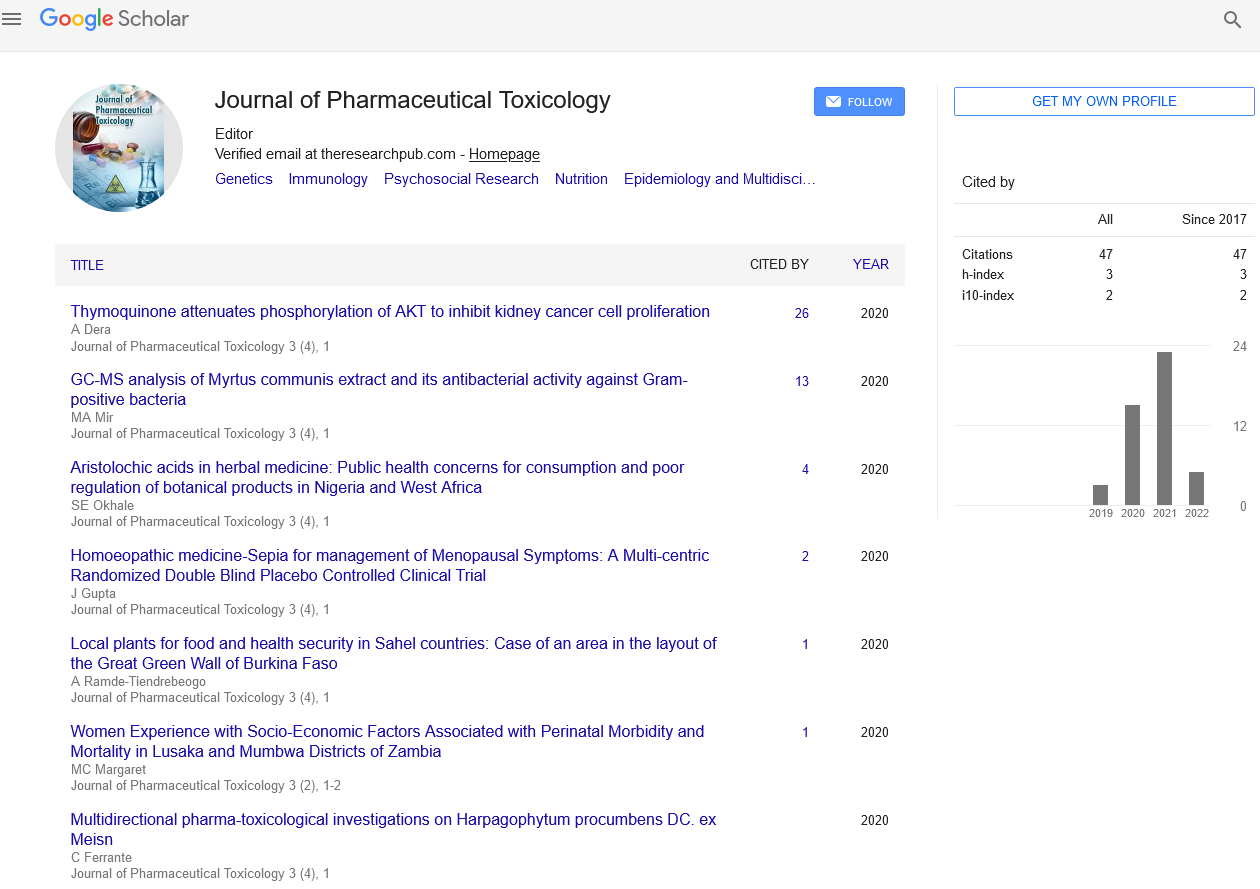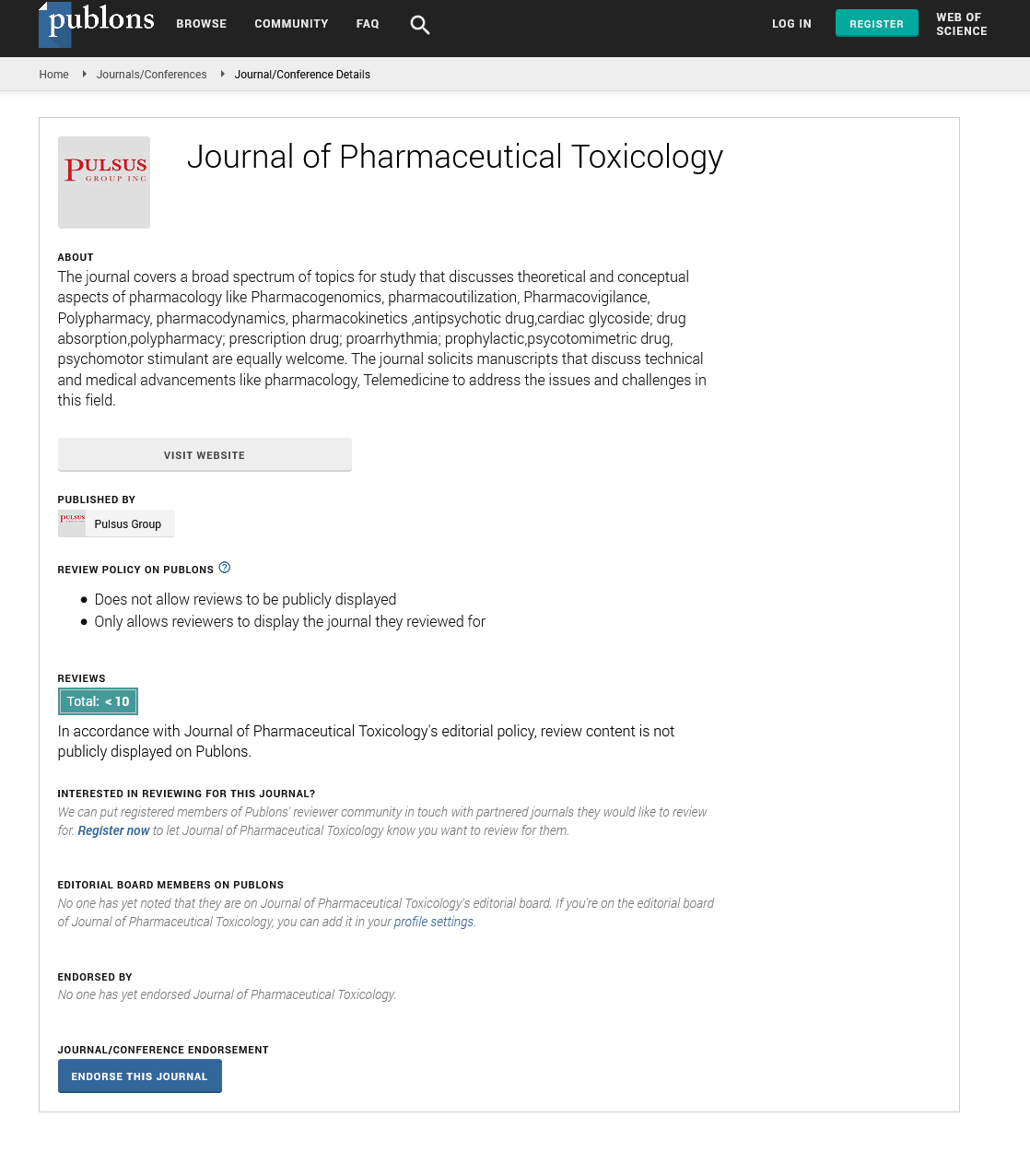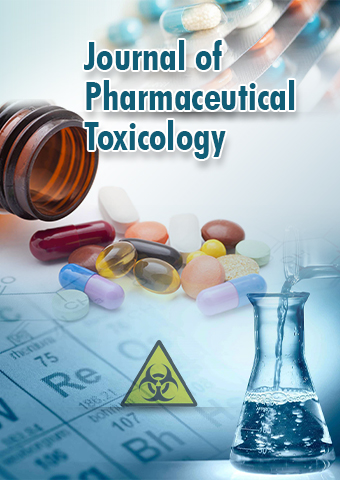Editorial - Journal of Pharmaceutical Toxicology (2023) Volume 6, Issue 4
Pharmaceuticals are classified into Prescription and Over-The-Counter (OTC) Medications
Zhen Huang*
Department of Medicine, Penn State University College of Medicine, USA
Department of Medicine, Penn State University College of Medicine, USA
E-mail: zhen_t221@gmail.com
Received: 01-August-2023, Manuscript No. oajpt-23-108572; Editor assigned: 3- August -2023, PreQC No. oajpt-23-108572 (PQ); Reviewed: 17- August -2023, QC No. oajpt-23-108572; Revised: 22- August -2023, Manuscript No. oajpt-23-108572 (R); Published: 28- August -2023; DOI: 10.37532/ jpt.2023.6(4).118-121
Abstract
Pharmaceuticals, also known as drugs or medications, refer to substances or compounds that are used to diagnose, treat, prevent, or alleviate various medical conditions and diseases in humans and animals. The field of pharmaceuticals is a crucial aspect of healthcare and plays a significant role in improving the quality of life and extending lifespan. The development of pharmaceuticals involves a rigorous process that includes research, clinical trials, regulatory approval, and manufacturing. Here are some key points to explain pharmaceuticals. Pharmaceutical companies and research institutions conduct extensive studies to identify potential compounds that may have therapeutic effects on specific diseases. This stage involves computer-based drug design, high-throughput screening, and various laboratory tests to assess the compounds’ efficacy and safety
Keywords
Pharmaceuticals • Cerebrovascular diseases • Drug discovery • Clinical trials
Introduction
After identifying promising compounds, preclinical studies are conducted on animals to evaluate their safety, efficacy, and possible side effects before moving on to human trials. These studies help researchers understand the potential risks and benefits of the drug. Once a compound shows promise in preclinical studies, it progresses to clinical trials, which involve testing the drug on human volunteers. Clinical trials are conducted in multiple phases (Phase I to Phase III) to assess the drug’s safety, dosage, effectiveness, and potential interactions with other medications. These trials are tightly regulated and require ethical approval.
After successful completion of clinical trials, pharmaceutical companies submit their data to health authorities such as the Food and Drug Administration (FDA) in the United States or the European Medicines Agency (EMA) in Europe. These agencies review the data and decide whether the drug can be approved for commercial use. Pharmaceuticals refer to a class of medical products that are designed and manufactured to diagnose, treat, prevent, or manage various diseases and health conditions in humans and animals. These products can take the form of drugs, vaccines, biologics, or other types of medicinal substances. Pharmaceuticals play a crucial role in modern medicine, contributing to the advancement of healthcare and improving the quality of life for countless individuals [1,2].
Once a pharmaceutical product receives regulatory approval, it moves into large-scale manufacturing. This involves producing the drug in controlled and standardized conditions to ensure its quality, safety, and consistency. Distribution and Marketing: Pharmaceutical companies work with healthcare providers, pharmacies, and distributors to make their products available to the public. They engage in marketing activities to educate healthcare professionals and the public about the drug’s benefits and usage [3,4].
Material & Methods
Healthcare professionals and patients can report any suspected side effects, and the drug’s safety profile is continually evaluated. Pharmaceuticals encompass a wide range of treatments, including over-the-counter medications, prescription drugs, vaccines, and more specialized Material & Methods Healthcare professionals and patients can report any suspected side effects, and the drug’s safety profile is continually evaluated. Pharmaceuticals encompass a wide range of treatments, including over-the-counter medications, prescription drugs, vaccines, and more specialized
Pharmaceuticals are designed to address specific health conditions, ranging from common ailments like headaches and allergies to chronic illnesses like diabetes and hypertension. They can be used for various purposes, such as alleviating symptoms, curing diseases, or preventing infections. Pharmaceuticals come in different forms, including tablets, capsules, injections, creams, ointments, and more. Each type of pharmaceutical has its own method of delivery and absorption into the body, depending on the condition being treated and the desired therapeutic effect. Pharmaceuticals are distributed through various channels, including pharmacies, hospitals, clinics, and sometimes directly to patients. Pharmacists play a vital role in dispensing medications, providing instructions, and ensuring patients understand how to use them safely and effectively.
Results
The development of a new pharmaceutical involves several stages, starting with extensive research and laboratory testing to identify potential drug candidates. Promising candidates then undergo preclinical studies using cells and animals to evaluate safety and effectiveness. If successful, the drug proceeds to clinical trials, which involve testing on human volunteers to assess its safety, efficacy, and optimal dosage. The data from these trials are submitted to regulatory agencies for approval before the drug can be marketed to the public.
Prescription vs. Over-the-Counter (OTC): Pharmaceuticals are classified into prescription and over-the-counter (OTC) medications. Prescription drugs require a healthcare professional’s authorization, as they may have more potent effects or potential side effects. OTC drugs, on the other hand, can be purchased without a prescription and are typically used to treat milder conditions or symptoms.
Once a pharmaceutical patent expires, other manufacturers can produce and sell generic versions of the drug. These generic drugs have the same active ingredients and efficacy as the original brand-name version but are often more affordable.
Safety and side effects
While pharmaceuticals can be highly beneficial, they also have the potential to cause side effects and adverse reactions. This is why extensive testing is essential during drug development, and healthcare professionals carefully consider a patient’s medical history and current medications before prescribing them.
Drug interactions
Some pharmaceuticals may interact with other medications, food, or substances, leading to potential complications or reduced effectiveness. It is essential for patients to inform their healthcare providers about all the drugs and supplements they are taking to avoid harmful interactions.
Pharmacovigilance
After a pharmaceutical is approved and available in the market, ongoing monitoring and reporting of adverse effects are conducted through a system known as pharmacovigilance. This helps ensure that any safety concerns are identified and addressed promptly.
Discussion
Overall, pharmaceuticals have significantly improved healthcare outcomes and have played a vital role in extending and enhancing the quality of life for millions of people worldwide. However, their use should always be approached with caution, and patients are advised to follow their healthcare provider’s instructions and seek professional advice if they have any concerns or questions about their medications. Pharmaceuticals have revolutionized healthcare by providing effective treatment options and preventive measures for a wide range of medical conditions. However, their development, regulation, distribution, and use require ongoing efforts to ensure safe and responsible use to benefit society as a whole. Pharmaceuticals refer to a broad category of medical products that are designed to diagnose, treat, prevent, or alleviate various health conditions and diseases in humans and animals. These products can take various forms, including drugs, medications, vaccines, and biologics [5,6]. The pharmaceutical industry plays a crucial role in healthcare, as it focuses on research, development, production, and distribution of these products.
The pharmaceutical industry is critical to advancing medical knowledge and improving global health. However, it is also subject to ethical considerations, such as the responsible promotion of medications, transparency in research, and ensuring affordable access to essential medicines for patients in need. Pharmaceuticals refer to drugs or medicinal substances used for diagnosing, treating, preventing, or managing various medical conditions and diseases in humans and animals. They play a crucial role in modern healthcare and have significantly improved the quality of life and life expectancy for many individuals.
Pharmaceuticals are developed through a complex process that involves scientific research, preclinical studies, clinical trials, regulatory approvals, and manufacturing. Here is an overview of the pharmaceutical development process. Pharmaceutical companies and research institutions conduct extensive studies to identify potential drug targets, which are specific molecules or processes in the body involved in a particular disease. This phase involves basic laboratory research, often using cells, tissues, or animal models to understand the disease’s underlying mechanisms.
Once potential drug candidates are identified, they undergo preclinical testing in animals to assess their safety, efficacy, and pharmacokinetics (how the body processes the drug). These studies help researchers determine the drug’s potential side effects and the appropriate dosage range for further human testing. Pharmaceuticals cover a wide range of medications, including prescription drugs, over-the-counter medicines, vaccines, biologics (medications derived from living organisms), and more. They are essential tools in the prevention, treatment, and management of various medical conditions, helping to improve and save countless lives worldwide. Pharmaceuticals, also known as drugs or medications, are substances that are designed to diagnose, treat, prevent, or cure medical conditions and diseases in humans and animals. These substances can be derived from various sources, including natural compounds, chemical synthesis, or biotechnological processes [7,8].
The development of pharmaceuticals involves rigorous research and testing processes to ensure their safety, efficacy, and quality. Here are the key steps in the pharmaceutical development process: Scientists identify potential drug targets and compounds that may have therapeutic effects based on understanding disease mechanisms or screening various chemical libraries. In this stage, researchers conduct laboratory tests and experiments on cells, tissues, and animals to assess the compound’s safety and effectiveness. The goal is to identify the most promising drug candidates for further development. Pharmaceuticals, also known as drugs or medicines, are substances used to prevent, diagnose, treat, or cure diseases, medical conditions, and health issues in humans and animals. These substances are carefully formulated and tested to have specific therapeutic effects on the body. Pharmaceuticals play a crucial role in modern medicine, contributing to improved health outcomes and increased life expectancy [9,10].
Conclusion
The process of developing a new pharmaceutical involves extensive research and development. It begins with preclinical studies, where the drug’s safety and effectiveness are evaluated in laboratory and animal models. If the results are promising, the drug goes through several phases of clinical trials involving human subjects. Once the clinical trials demonstrate safety and efficacy, regulatory authorities, such as the U.S. Food and Drug Administration (FDA) or the European Medicines Agency (EMA), review the data and decide whether to approve the drug for public use. Pharmaceuticals exert their effects in various ways, depending on their intended purpose. Some drugs work by targeting specific molecules or receptors in the body to alter biochemical pathways, while others may enhance or inhibit certain physiological processes.
The process of developing a new pharmaceutical involves extensive research and development. It begins with preclinical studies, where the drug’s safety and effectiveness are evaluated in laboratory and animal models. If the results are promising, the drug goes through several phases of clinical trials involving human subjects. Once the clinical trials demonstrate safety and efficacy, regulatory authorities, such as the U.S. Food and Drug Administration (FDA) or the European Medicines Agency (EMA), review the data and decide whether to approve the drug for public use.
References
- Ogurtsova K, Fernandes JD, Huang Y et al. IDF Diabetes Atlas Global estimates for the prevalence of diabetes. Diabetes Res Clin Pract. 128, 40-50 (2017).
- Zhou Z, Mahdi A, Tratsiakovich Y et al. Erythrocytes From Patients With Type 2 Diabetes Induce Endothelial Dysfunction Via Arginase I. J Am Coll Cardiol. 72, 769-780 (2018).
- Sprague RS, Stephenson AH, EA Bowles et al. Reduced expression of Gi in erythrocytes of humans with type 2 diabetes is associated with impairment of both cAMP generation and ATP release. Diabetes. 55, 3588-3593.
- Blaslov K, Kruljac I, Mirošević G et al. The prognostic value of red blood cell characteristics on diabetic retinopathy development and progression in type 2 diabetes mellitus. Clin Hemorheol Microcirc. 71, 475-481 (2019).
- Venerando B, Fiorilli A, Croci G et al. Acidic and neutral sialidase in the erythrocyte membrane of type 2 diabetic patients. Blood. 99,1064-1070 (2002).
- Kadiyala R, Peter R, Okosieme OE et al. Thyroid dysfunction in patients with diabetes: clinical implications and screening strategies. Int J Clin Pract. 64, 1130-1139 (2010).
- Clark A, Jones LC, de Koning E et al. Decreased insulin secretion in type 2 diabetes: a problem of cellular mass or function. Diabetes. 50, 169-171 (2001).
- DeFronzo RA. Pathogenesis of type 2 diabetes: metabolic and molecular implications for identifying diabetes genes. Diabetes Reviews. 5, 177-269 (1997).
- Peppa M, Betsi G, Dimitriadis G et al. Lipid abnormalities and cardio metabolic risk in patients with overt and subclinical thyroid disease. J Lipids. 9,575-580 (2011).
- Cettour-Rose P, Theander-Carrillo C, Asensio C et al. Hypothyroidism in rats decreases peripheral glucose utilisation, a defect partially corrected by central leptin infusion. Diabetologia. 48,624-633 (2005).
Google Scholar, Crossref, Indexed at
Google Scholar, Crossref, Indexed at
Google Scholar, Crossref, Indexed at
Google Scholar, Crossref, Indexed at
Google Scholar, Crossref, Indexed at
Google Scholar, Crossref, Indexed at
Google Scholar, Crossref, Indexed at
Google Scholar, Crossref, Indexed at
Google Scholar, Crossref, Indexed at


